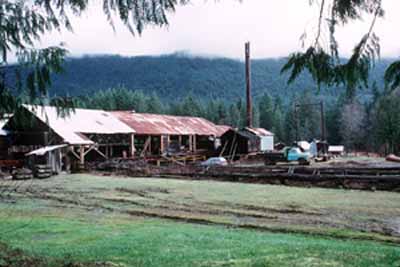McLean Mill National Historic Site of Canada
Port Alberni, British Columbia

General view
© Parks Canada Agency / Agence Parcs Canada, 1996.
Address :
5633 Smith Road, Port Alberni, British Columbia
Recognition Statute:
Historic Sites and Monuments Act (R.S.C., 1985, c. H-4)
Designation Date:
1989-06-22
Dates:
-
1925 to 1965
(Construction)
Event, Person, Organization:
-
Robert Bartlett McLean
(Builder)
-
Cora McLean
(Builder)
-
Arnold McLean
(Builder)
Other Name(s):
-
McLean Mill
(Designation Name)
-
R.B. McLean Sawmill
(Other Name)
-
R.B. McLean Lumber Co.
(Other Name)
Research Report Number:
1988-A03, 1989-39A&C
Plaque(s)
Existing plaque: 5633 Smith Road, Port Alberni, British Columbia
A legacy of the early British Columbia forest industry, this steam-powered sawmill is typical of many operations that flourished in the province from the 1880s to the 1940s. Although small in scale, it contains many elements of larger coastal mills including the log haul and double circular saws. Completed in 1927 by the R.B. McLean Lumber Company, a family business, the mill is enriched by associated resources that tell the story of logging, transportation and labour. Together, they commemorate an industry that has dominated economic and social life in British Columbia.
Description of Historic Place
McLean Mill National Historic Site of Canada is a former sawmill and logging operation located on 13 hectares of forested land in the Alberni Valley of Vancouver Island. The formal recognition consists of some 35 structures and the land surrounding them. Built resources include an operational steam operated sawmill, and ancillary structures including a wide variety of wooden garages, storage structures and outbuildings, a cluster of wooden residences and administrative buildings, and a rail line. Landscape features include outdoor areas for processing and storage of lumber, and a mill pond.
Heritage Value
McLean Mill was designated a national historic site of Canada in 1989 to commemorate: its collection of extant resources related to logging, sawmilling, transportation and labour; and, its close association to significant aspects of the forest industry.
McLean Mill is a rare, surviving example of an early- to mid-20th-century logging and lumber operation in British Columbia. Established in 1925 by Robert Bartlett McLean, his wife Cora and their three sons, it continued as a family-run operation until 1965. Built resources at the site were constructed of local materials by the McLean family and their workers. The deliberate creation of zones of activity is still plainly visible. The site includes a steam-powered sawmill and original machinery representative of the range of activities undertaken in the forest industry. Built resources and machinery span the 40 years of mill operation, demonstrating the typical components of a British Columbia sawmill and logging operation and their evolution over that period. The site also includes transportation facilities for a steam-powered locomotive.
Sources: Historic Sites and Monuments Board, Minutes, June 1989; Commemorative Integrity Statement.
Character-Defining Elements
Key elements that relate to the heritage character of McLean Mill include: the location of the site within a forested area, close to Port Alberni; the utilitarian design and materials of structures at the site as illustrated in the wood construction of buildings, including heavy timber construction, light frame construction, vertical and horizontal weather-board siding, and wood-shingle and corrugated-metal roofing; the use of local, unfinished red cedar and Douglas fir in building construction; the rough plank boards of early buildings and the more refined timber of later buildings; the division of the site into zones of activity, including the cleared area east of the mill pond, containing a collection of garages, sheds and log dumps associated with the mill’s logging operations, the main sawmill and its outbuildings at the northwest part of the site, the village-like cluster of residential and administrative buildings at the southern part of the site, and the shipping area at the westernmost part of the site, containing the rail line and related structures; the relationship of built structures at the site to each other and to landscape features; buildings and structures related to the logging operation, including the donkey boom, the log dump, the gas and oil building, the main garage, and the jill poke; buildings and structures related to the sawmill operation, including the main sawmill building and its component equipment, the power house, comprised of the Boiler Building and the adjoining Sawdust Bin, the green chain or lumber pile deck, the planer mill, the jack ladder, the log carriage, the yard office, the local office, the burning pit, the conveyor, the sawdust storage, the dam, the transformer platform, and the lumber piling yard; surviving workers’ housing and related facilities, including the bunkhouse, the middle cabin, the workers’ housing, the workers’ cabin, the bookkeepers’ cabin, the main house, the cookhouse, and the local office garage; buildings and structures related to transportation, including the loading dock, the rail bed, and the locomotive shed; the mill pond used for floating and sorting lumber, including, the dam across the Kitsukis Creek, the stone retaining wall, and the lumber fish ladder for salmon.